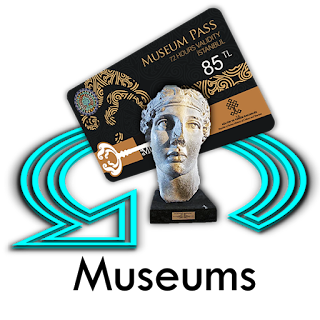Traditional Turkish Cuisine
Turkish cuisine is seen as of the three richest and oldest cooking traditions of the world together with French and Chinese cooking.
While it has come to be associated with kebap, baklava, lokum and rakı there is a rich and variegated tradition of soups, olive oil dishes, rice pilafs, stuffed vegetables, pastries, puddings and syrupy desserts underlying these popular dishes. It offers unique tastes in spicy and tart appetizers, pickles, fruit preserves, compote, sherbet, boza (a thick beverage made of barley) and coffee.
The diversity of Turkish cuisine reflects the cultures of the populations living in regions highly dissimilar in geography and climate. This has led to an abundance of ingredients and cooking styles. The Southeast and the East are known for the dishes based on cracked wheat and meat with hot spices, the Aegean, for olive oil dishes enhanced with local herbs, the Black Sea region, for varieties of anchovy and collard, and Istanbul is a world unto itself with, among others, eggplant dishes which come in no less then 41 sorts.
The latest trend in İstanbul restaurants is the fast food version of the traditional simit (kind of bagel) and börek (pastry)
.
.
Stuffed vegetables and wraps
They constitute a unique aspect of Turkish cuisine. The classical wrap is meat or rice wrapped in vine, cabbage or collard leaves although lettuce, nut, chestnut, cherry and even violet leaves are sometimes used. There are about 15 varieties of vegetables stuffed with meat today.
Stuffed Eggplant and Peppers Stuffed Vine Leaves in Olive Oil
Meat dishes
There is a rich variety including gyros type dishes, grills, fried meats, kebaps, stews, meat cooked in a crock or pan. There are also boiled meats, meat balls, vegetables stuffed with meat and meat dishes cooked with fruits.
Olive oil dishes
They are an integral part of lunch and dinner especially in the summer. They can be served warm or cold. Olive (or vegetable) oil can be used to fry eggplants, peppers and zucchini or cook them in an onion and tomato sauce and letting them simmer.
Fava ( The mashed broad beans ) Red Pepper Roast
Ramadan tables
The food is less heavy than it once was but still consists of a long menu including soup, a meat dish, choice of pastry, pilaf or pasta, olive oil dish, salad and dessert. The tradition of inviting friends and relatives to elaborate dinners to break the fast continues. Food is accompanied by the pides which can be bought hot at the neighborhood bakery on Ramadan afternoons.
Istanbul cuisine
It is the cuisine of an imperial city featuring a wide variety of ingredients and cooking styles. It includes dishes and ideas from the cuisine of Jews, Greeks and Armenians who were an integral part of Ottoman society.
Modern-day Turkish cuisine is mostly the heritage of Ottoman cuisine, which some might correctly describe as being a fusion and refinement of culinary traditions from neighboring countries, as well as the Middle East, Central Asian and Western European influences. This of course stems from the many centuries in which the Ottoman Empire waged war with many of the European peoples in Central and Eastern Europe.
Having had to deal with a wide mix of cultures and peoples it only makes sense for Turkish cuisine to show an incredible amount of variety on the same theme. Let’s take the Black Sea region for instance, where there are over twenty different dishes that incorporate corn as well as a plethora of ways of preparing hamsi – a sardine-like. The interesting thing being that of course, you will find dishes similar to these in the surrounding countries of Bulgaria, Romania and so on.
Kebabs
 |
| Ottoman Cuisine & Istanbul Cuisine |
Possibly one of the most international ubiquitous Turkish dish is the kebab. These are a great example of both variety and simplicity in action. They are made from either plain or marinated meat which is then either stewed or grilled – most commonly grilled in the West. In Turkey, each district in the country has its own special recipe.
The ‘Sis kebab’, which is famous the world-around is made from pieces of lamb threaded on a skewer and griller over charcoal, then there’s the ‘Doner kebab’ which is made from a roll of lamb on a vertical skewer turning parallel to a hot grill, and these are just two of the most popular versions.
Turkish sweets
The results of the Turks’ sweet-tooth are famous throughout the world. Many of the sweets in Turkey are milk based but possibly the best well known are the pastries, respectively ‘baklava’ and ‘kadayif’.
Then of course there’s Turkish delight or Lokum, which is a unique type of confection made on a gel of starch and sugar. Some varieties will include pieces of nuts and fruit bound in the gel. The confections are packaged in small cubes which are usually dusted with icing sugar in order to prevent them from sticking to each other.
Turkish beverages
Turkish coffee is chief amongst the national drinks, being of such important to the daily life of the Ottoman Empire that it introduced coffee and the idea of a coffee house to all the countries that they warred with. Turkish coffee is thick and dark and is served in a small cup. The process of making the coffee is a particular one as well, one which we’ll not detail here.
Turkish Tea Turkish Coffee
Obviously we’ve only skimmed the surface of the massive and intricate labyrinth that Turkish cuisine is, visiting Turkey will surely result in you discovering many other interesting foods and drinks.
 |
| Turkish Cuisine & Ottoman Cuisine - Photos |






















